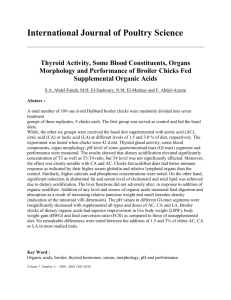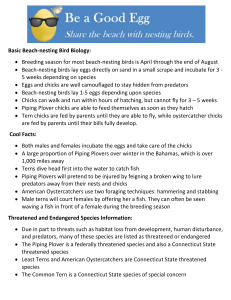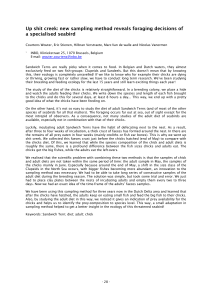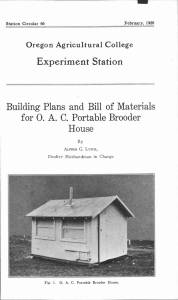and Rearing Chick Brooding
advertisement
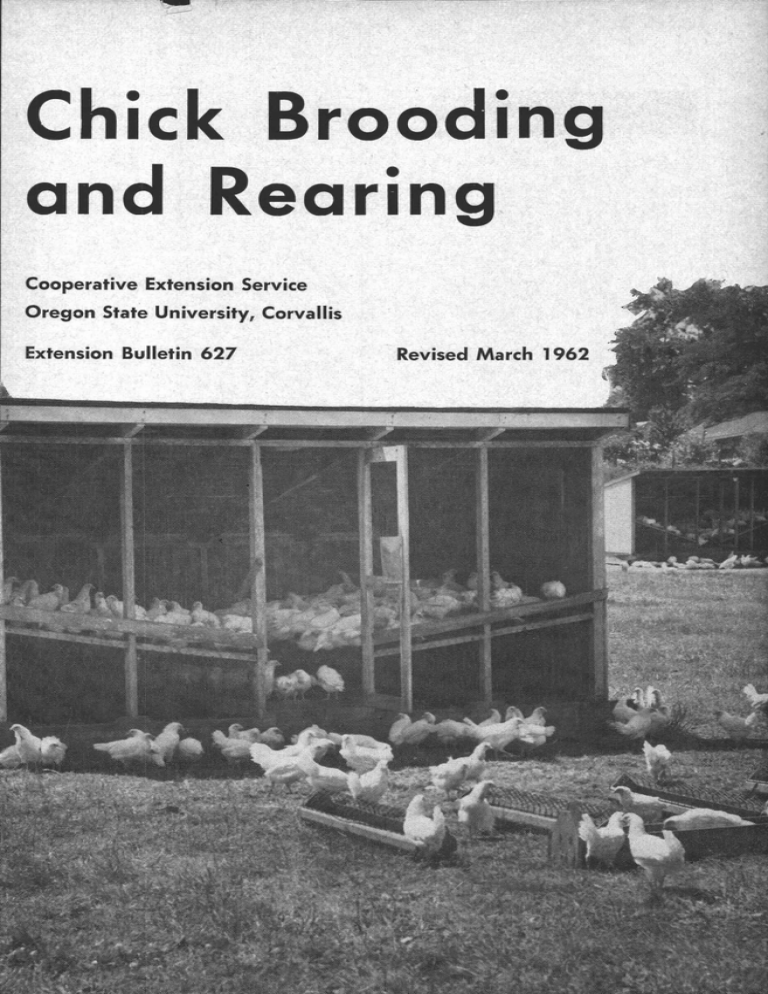
'MUM Chick Brooding and Rearing Cooperative Extension Service Oregon State University, Corvallis Extension Bulletin 627 Revised March 1962 Chick Brooding and Rearing Revised by J. E. PARKER, Professor of Poultry Science and N. L. BENNION, Extension Poultry Specialist chickens are raised chicks. Poor equipment or management brooding and rearing of some kind will can ruin the best chicks ever hatched. It is important, therefore, that poultrymen have an understanding of equipment and management necessary for on a commercial scale, artificial WHEREVER be used extensively. Good brooding and rearing, along with good manage- ment, can be made to bring out the successful brooding and rearing of best qualities inherited by a group of chicks. Brooder Houses Under Oregon conditions artificial brooding cannot be carried on success- fully without a satisfactory brooder house. Portable brooder house Very satisfactory brooding results can be obtained with a house 8 to 10 feet wide by 10 to 14 feet long built on runners that make it possible at intervals to move the house to clean ground. Oregon Extension Bulletin 652, 0. S. C. Brooder Houses, contains information on the construction of a tion of a laying house, preferably a new one, as a brooder house. Where laying houses are used for brooding chicks, the adult stock should be removed prior to the brooding season and the house thoroughly cleaned and disinfected. The erection of temporary partitions in the laying house, dividing it into rooms or pens, gives best results. These temporary partitions can be constructed by using a board 1 inch by 12 inches as a baseboard, above which at least 4 feet of wire netting is stretched. Plywood also may be used portable brooder house. to build partitions in laying houses. Stationary brooder house and provide ample protection from Where chicks in commercial numbers are to be brooded annually, a permanently located brooder house is generally desirable. Panels of plywood are easy to arrange drafts. Keep confined It is important not to permit chicks A house of this type can be built on ground previously used by laying any length desired, depending on the hens as such ground is likely to be number of chicks to be brooded. Brooding in laying houses A shortage of brooding capacity often can be overcome by using a sec2 contaminated with parasites and disease organisms. When brooding in a laying house, therefore, it is advisable to keep the chicks confined to the house. Artificial Yards When chicks are raised or brooded year after year and have access to the same ground, that ground usually becomes so heavily infested with parasite eggs and disease organisms of various kinds that satisfactory brooding upon it is no longer possible. Under pings, and if chicks can reach it the such conditions the chicks may be confined to the house during the brooding period or provided with artificial to permit cutting the vegetation. yards. In recent years the trend has been away from the use of artificial yards or porches. very object of having the porch is defeated. An application of oil or weed poison to the ground under the porch is one method of controlling grass and weed growth. Another way is to build the wire porches in removable sections Cement porches Another type of artificial yard that may be used is the cement porch. This should be constructed as long as the brooding room with a slope away from the brooder house at the rate of about Wire porches One type of artificial yard sometimes used in Oregon is the wire porch. A porch 6 feet wide and as long as the three-fourths inch to one foot. Provi- sion should be made for hosing off cement porches every few days during brooding room will provide sufficient the brooding period. As this hosing area if the cockerels are removed as takes time, cement porches require soon as they can be identified. The more labor than wire porches. wire should be no smaller than 18gauge, 1-inch mesh, and galvanized. Board or lath porches Either 1- x 1-inch or 1- x 2-inch welded Board or lath porch floors may be wire, 121- or 14-guage, may be used. used as artificial yards and, provided No vegetation high enough to allow they are oil treated for ease of cleanthe chicks to reach it should be per- ing and protection against weather, satmitted to grow under the wire porches. Such vegetation is contaminated from an accumulation of the chicks' drop- isfactory results can be obtained. Lath porch floors can be made from 11-inch slats placed from 1 to 11 inches apart. Brooder House Capacities Straight-run chicksapproximately Sexed day-old pullets should be half pullets and half cockerels as they provided with a minimum of 100 square feet of floor space for 100 ordinarily hatchshould be given a minimum of 50 square feet of floor pullets. They do not need that much at space for each 100 day-old chicks where from 300 to 500 are brooded first but soon will. Commercial broiler growers should together. It is assumed that the cocker- allow from 75 to 100 square feet of els will be removed as soon as they can be distinguished because the growing pullets will need the space. floor space for 100 chicks. For rapid, uniform growth and best use of feed broilers must not be over-crowded. 3 Brooder Capacities many brooders are in excess of their actual capacities. Experiments have shown that the best results will be obtained by not exceeding the following For straight-run chicks a minimum of 7 square inches of floor space under the hover should be available for each chick at the start. The removal of males as soon as they can be distinguished gives pullets more room. For sexed pullets 10 to 14 square inches of floor space per chick under recommendations. the hover should be provided. Satisfactory brooding results are impossible where chicks are crowded un- der brooders of any type. Unfortunately the advertised capacities of Brooders The heat necessary for artificially brooding chicks may be supplied by a wide variety of devices. Those described in the following paragraphs are the ones most widely used in Oregon. Electric brooders During recent years the use of electric brooders has increased in popularity. Many commercial makes of elec- tric brooders are on the market that will give satisfactory results. Figures 1 and 2 illustrate two types of electric brooders used at Oregon State University. Figure 2. An electric brooder with ventilating fan attachment operating in an OSU brooder house room. stationary Kerosene or fuel-oil brooders Recent improvements in the designs of kerosene or fuel-oil brooders have greatly reduced the fire hazard that in the past made them objectionable. Several satisfactory makes are now available. Gas brooders Satisfactory brooders using gas from Figure 1. An electric brooder in operation in an OSU stationary brooder house room. 4 city systems or from portable tanks are now available. Both natural gas and bottle or tank gas are dependable as a source of heat. Several satisfactory gas brooders are on the market. Wood-burning brooders Satisfactory commercial brooders burning wood for fuel have been developed and are available. Hot-water brooders In a large stationary brooder house it is possible to install a hot-water system that will convey water heated in a central boiler to each of the brooder rooms. Obviously an installation of this kind is quite complex and each must be considered an individual problem. Figure 3. Battery brooders containing Leghorn chicks. Battery brooders Commercial battery brooders of several makes are available. Generally, the starting units, illustrated in Figure 3, are equipped with their own electric heaters. In many types these heaters are removable and are taken out when the chicks no longer require supplementary heat. As the chicks grow, they require more space. Since this is not available in starting units that are filled to capacity with day-old chicks, there are also available intermediate and finishing battery brooders. These are similar to the starting units in construction except that they are progressively larger in their dimensions and have no heating equipment, which reduces their cost price considerably. In some large installations, instead of the starting units having their own heaters the entire room in which they are located is heated to the desired temperature. In the use of battery-brooding equipment the day-old chicks are placed in I starting units where they should have a minimum of 10 square inches of floor space each. Because of their progressive growth it is necessary to allow the chicks more space at 2-week periods. The minimum floor space al- lowances for each chick in batteries should be increased for each 2-week interval by 10 to 15 square inches. Each chick carried beyond the 10th week should have a minimum of 72 square inches of floor space. The chicks that go into one starting battery at the beginning of their brooding period will fill four batteries of comparable size when 7 weeks old or when they normally can do without supplementary heat. These same chicks, if they are reared to 8 to 9 weeks of age or to broiler weights will require space equal to that of six starting batteries. Hatcherymen find chick battery equipment very valuable to them when they have to hold chicks for periods of a few days. Some poultrymen use chick battery equipment to start chicks 5 for the first week or 10 days before transferring them to floor brooding tritionally balanced rations will give equipment. Regardless of the particular objective for which battery equipment Batteries for broilers is operated, it is important to house it in well-insulated buildings so con- satisfactory results for battery feeding. Battery equipment is used to a considerable extent by broiler growers who structed as to afford the operator a are producing regular volumes over maximum of control over temperature, long periods of time. Batteries may be best suited to plants that dress their own birds as there is a general belief It is possible to rear pullets to mathat battery-reared chicks are soft and turity in battery equipment but the practice is not generally recommended the shrinkage or weight loss in shipunder Oregon conditions as it is be- ment of live chickens is greater than ventilation, light, and humidity. lieved that pullets can be produced more economically with normal brooding methods. Battery feeding Chicks started and reared in batteries should be fed the same type of wellbalanced ration used for chicks raised under a floor plan of brooding. All nu- with floor-reared birds. When chicks are raised to weights exceeding 2 to 21 pounds in batteries, they are prone to have breast blisters. Irritation of the skin over the breast 11 bone caused by contact with the wire floor may cause an accumulation of fluid under the skin which resembles a blister. Feeding Equipment Baby chicks do not require complicated or expensive feeding equipment. Satisfactory home-made equipment for this purpose is shown in Figure 4. It is very important to see that enough both ends so that it revolves easily if chicks attempt to roost on it. This will keep the chicks out of the feed. Feeders should be placed on low stands, as shown in Figure 4, when the chicks feeding and drinking space is provided. reach 4 weeks of age. Mash troughs Watering devices For the first 2 weeks a satisfactory shallow mash tray may be made from a board 1 x 4 or 1 x 6 inches edged A deep can that is set in a pan of appropriate size as a guard makes a with lath. One of these trays 4 feet long should be provided for each 100 chicks. For use after the first 2 weeks of feeding, a trough 4 inches deep, 4 to 6 inches wide, and 4 feet long should be provided for each 100 chicks. It is de- good home-made watering device for starting the chicks. At least one drinking vessel with a capacity of from 2 to 4 quarts should be provided for each 100 chicks at the start. Square frames made of 1 x 4-inch boards and covered with 1-inch mesh hardware cloth make desirable stands on which to place sirable to equip the tops of these drinking vessels to prevent the chicks troughs with a square stick pivoted at from contacting wet litter. Figure 4 6 Figure 4. Chick feeding equipment. shows the home-made watering device and stand. After the second week of brooding the watering capacity should be increased. Automatic or drip type fountains are an advantage where running water is available. Scales and feed bucket A feed bucket and milk scales, as shown in Figure 4, are convenient for the increasing number of producers in- terested in keeping accurate feed or cost-account records. Feeding the Chicks Any successful method of feeding is based upon supplying in reasonable bal- ance the six so-called essential nutrients; namely, carbohydrates, fats, protein, minerals, vitamins, and water. Lack of any one nutrient from the diet will soon make itself evident either necessary for complementing the other, and together in correct proportion they form the balanced ration. Carbohydrates and fat Cereal grains furnish the basis for poultry mash and grain mixtures. They through slowing the growth rate or furnish large quantities of carbohy- through the appearance of nutritional deficiency diseases. Each nutrient is drates and some fat, the chief sources of heat and energy used by the body. 7 Proteins Proteins furnish the necessary elements for growth of tissue and body repair. Vegetable proteins from soybean oil meal, cottonseed meal, and peanut meal have during late years been used to furnish an increasing amount of protein for poultry feeds. When supplemented with as little as 2 percent animal protein from such sources as meat meal, fish meal, or dried skim milk, they yield highly satisfactory results. Figure 5. Curly-toe para ysis, shown on left, due Minerals Minerals are essential for bone development. Chief sources of calcium and phosphorus, two of the essential mineral elements, are oystershell, limestone, bonemeal, defluorinated rock phosphates, and colloidal clay. Sodium and chlorine are added to the ration as ordinary salt, while manganese is added in very small amounts in the form of a manganese salt. These are essential to supplement the deficiencies of grains and the vegetable protein concentrates. Vitamins Vitamins are important for normal growth and when absent produce certain characteristic disease symptoms. Poultry diets generally are checked for the presence of vitamins A and D, B12, riboflavin, and pantothenic acid. Other vitamins, while important, are furnished by ingredients normally used. Vitamin A is important for preventing infections of the eyes and respira- to a deficiency of riboflavin, was corrected within 2 days (right) when adequate riboflavin was added to balance the diet. needled particularly in the diets of breeder hens and starter rations for good hatchability and to prevent curly- toe paralysis, an example of which is shown in Figure 5. Pantothenic acid is required to prevent skin dermatitis. Both of these vitamins are found in about the same list of ingredients; namely, green feeds, dried alfalfa products, dried skim milk, dried whey, yeast, liver meal, and distillery byproducts. Antibiotics Antibiotics, like vitamins, are substances required in minute amounts for maximum growth and efficiency of feed use. A number are satisfactory and they are used in most broiler rations. tory tract. It is furnished in the ra- High-energy or high-efficiency mashes tion by use of dried alfalfa meal, yel- During the past few years there has been considerable interest in chick ra- low corn, green feeds, and fish Vitamin D is required oil. to prevent rickets and permit normal calcification of bones. Fish liver oils, irradiated products, and sunshine supply poultry tions high in energy and low in fiber. Such rations also supply ample amounts of the required vitamins and minerals and a good protein balance needs for this vitamin. Riboflavin is to supply, adequate amounts of the 8 amino acids required by the growing chicks. It is not at all unusual for broiler growers to produce a pound of broiler on as few as 2 to 2.5 pounds of feed with these rations. Although high-energy mashes cost more per 100 pounds, many broiler growers find that the faster growth and more efficient use of feed offset the higher cost. Chick rations - In most sections of Oregon satisfac- tory ready-mixed chick and broiler mashes and scratch feeds are available. Some poultrymen, however, may prefer to do their own mixing. Since chick starter and broiler ration formulas are subject to periodic revision, they are not included in this bulletin. They may be obtained on request in leaflet form from the Department of Poultry Science. While many poultrymen start feeding scratch grains from as early as 2 weeks to as late as 8 weeks of age, Table 1. many commercial broiler raisers prefer to feed only mash until the chickens are marketed. The chick feeding sched- ule given on the next page may be of value to less experienced chick raisers. When feeding commercial feeds, follow manufacturers' directions. Water Water is essential in the diet for aiding in digestion, absorption, circulation, control of temperature, lubrication, and the excretion of waste products. Growth rate Table 1 gives the average weights per chick in pounds at weekly intervals for White Leghorn, Rhode Island Red, and New Hampshire chicks brooded at Oregon State University. Using strains of chicks bred for rapid growth and feeding high-efficiency rations make it possible for some broiler growers to produce 3-pound chickens in 7 to 8 weeks. CHICK GROWTH RATE Replacements Age in weeks White Leghorns, Rhode Island Reds, sexed pullets straight run Pounds 0 .09 .13 .25 .24 .39 .60 .58 .80 1.07 1.37 1.61 1 2 3 4 5 6 1.00 7 8 Pounds .08 1.30 New Hampshires, straight run Pounds .08 .15 .30 .54 .82 1.15 1.50 1.90 2.30 9 CHICK FEEDING SCHEDULE Age Grain Drink Other factors Clean, fresh water before chicks at all Cover litter under the hover with egg-case flats for first 3 days. Water. Feed grit. Clean out wet litter. Mash Chick mash at all times, First week One tray 6"x4' for each 100 times. chicks. Second and third weeks Chick scratch may Chick mash be fed as early as at all times. Gradually change 2 to 3 weeks. to larger feed Reduce brooder temperature gradually starting second week. . hoppers. Fourth to eighth weeks Change gradually Chick mash to coarser scratch, at all times. At 6 to 8 weeks Water. Gradually change to coarser grit. Separate cockerels. Keep litter dry. Get pullets on roost by fifth week. Reduce brooder heat. Water. Provide clean range. Keep range houses, feed troughs, and drink. ing vessels widely separated. Provide shade on range; grit and shell in hopper; supplementary green feed if range grass is dry. Mash hoppers scratch grains can 4"x4"x6' with be fed free-choice, reel on top. Ninth week through to laying age Change to hen size Mash kept scratch, before pullets. Grain in hoppers at all times. Sexed Chicks The purchase of day-old sexed pul- is a practice now generally followed on Oregon commercial egg farms. If the chicks are properly lets handled while being sexed, there is no injury to them as chicks, or later. As the purchaser of day-old pullets pays for the undelivered cockerel and a sexing charge, it is to be expected that the sexed pullets raised to maturity will cost a few cents more than a pullet from an unsexed lot. If sexed pullets have more brooder space, under most farm conditions they will mature more evenly, have less severe disease outbreaks, and develop fewer cannibalistic habits. The slight increase in mature pullet cost is justified, except for farms having ample brooding equipment and especially advantageous broiler outlets not available to producers generally. Brooding Management Poultrymen can brood good chicks by following any one of numerous brooding-management plans. It is highly Ventilation Fresh air is necessary for the growth of healthy, vigorous chicks. Adequate advisable to select and follow faithfully a definite plan of management ventilation should be provided, but that has been used extensively and floor drafts must be avoided. The wingiven good results under Oregon condi- dows of OSU brooder houses are tions. It is wise to avoid fads because equipped with frames covered with muslin or a glass substitute. The top too often they prove expensive. 10 , sections can be tipped in, allowing fresh air without direct drafts. Litter Cut straw, shavings, cedar tow, sawdust, sand, or peat moss are used successfully for brooder-house litter in the various sections of Oregon. Litter should be dry when chicks are put on it. Since sand and sawdust are likely to be damp, they should be dried before being used. Alfalfa hay or chaff is used in some localities, but it makes rather inferior litter because of its marked tendency to ball up on the chicks' toes. When sand, sawdust, or peat moss is used, it is well to cover it with bur- lap or cloth for the first 2 or 3 days. This precaution prevents the chicks from eating litter instead of food before they have learned the difference. First, correct any shortcomings that may be discovered in feeding practices or housing facilities. Next, darken the brooding chamber by placing sacks, dark cloth, or paper over the doors and windows. Just enough light should be admitted to per- mit the chicks to see to move around. In quarters thus darkened they will do a minimum of picking. Several brands of anti-pick paste de- signed to control cannibalism are on the market. All poultrymen should keep a can of this material on hand. At the first sign of picking, smear this blood-colored, vile-tasting material gen- erously on not only all of the chicks that have been picked but on a dozen or more others that have not yet been attacked. The chicks will immediately start picking at this red material, presumably thinking it to be blood. One or two mouthfuls are sufficient to teach most chicks that all that is red is not Cannibalism The various causes of cannibalism are not thoroughly understood. No good to eat. If used in time, outbreaks often can be held in check by this simple, positive remedy is yet known. means. houses providing ample room of age helps in preventing or controlling cannibalism. In debeaking, the upper beak is cut back approximately inch with a knife, a pair of wire side cutters, or an electrical debeaking de- Broiler growers have found that deIt is known, however, that properly fed chicks, housed in good brooder beaking the chicks when 3 to 5 weeks per chick, as well as correct brooder and room temperatures, generally give less cannibalistic trouble than those improperly handled. No matter what may be the actual cause of a cannibalistic outbreak, it seems probable that after it has started habit plays quite a part in its continu- Chicks also may be debeaked when one day old. Some hatcheries perform this service at a small cost. vice. Clean litter, frequent feeding of ance. It is important, then, when an green feed, and the careful avoidance outbreak occurs, to check it before the of checking outbreaks of cannibalism, although none of them can be depended on as a certain cure. Brooding-management plan frightening or overheating the chicks learn the habit so thoroughly chicks are helpful also in preventing that it never can be stopped. Certain or reducing cannibalism. practices have been found helpful in Brooding rooms and all equipment should be thoroughly cleaned and dis11 milky color, is a good disinfectant. A cheaper and probably just as effective solution can be made by adding 1 can of common lye to 15 gallons of water, impossible, however, to give an absolutely definite rule as to the extent of this reduction as it will be affected by the out-of-door temperature, the type of brooder house, the number of chicks under the brooder, and other such variable factors. On the average, however, this reduction will be about I° per day, which solution can then be used for ac- which amounts to approximately 5° tually scrubbing the brooding rooms per week. Twenty-f our hours before actual brooding is to commence, the brooders should be started. Since they have been adjusted during the trial run, this final starting is a simple matter. Feed and water should be placed in the brooding enclosure just before infected several weeks before they are to be used. A solution of water and a coal-tar product, such as sheep dip, mixed in proportions to give a good and equipment. At least a week before brooding is to start, the litter should be put into the brooding rooms and all equipment set up. A 24-hour trial run of the brooder should then be made. This trial run gives an opportunity to discover and remedy any broken parts or other mechanical failures that may have developed in the brooder. It also dries out the litter if that is needed and gives an opportunity for adjusting the brooder to the desired starting temperature. The empty brooder should be regu- lated to a temperature of 92° to 95° Fahrenheit at a height of about 24 inches above the floor near the outside edge of the hover. The placing of the thermometer is of great importance in measuring correct operating temperatures of the brooder. It has been found that a wide variation may exist between temperatures taken at various points under the hover, this being particularly true for fanless electric brooders. After the chicks are put under the brooder, the experienced operator can tell whether they are comfortable by the way they act. If they crowd toward the center of the brooder, it is an indication that more heat is needed. Too much heat will drive them to the outer edge of the brooder. The temperature should be reduced gradually as brooding proceeds. It is 12 chicks are placed under the brooder. Egg-case flats may be used under the hover to cover the litter for an area equal to that of the brooder. Mash should be scattered over the flats in sufficient quantity for chicks to find it readily. The flats may be used for 3 or 4 days. Mash should be kept before the chicks at all times. Starting when chicks are 6 to 8 weeks old cracked grains and grit can be fed free-choice along with the mash. Chicks will balance their own ration and make satisfactory growth under this method of feeding. With certain rations where pasting-up is a problem, it has been found that feeding of scratch grain alone the first 2 days of brooding will aid in preventing this occurrence. Feed management for battery-reared birds is similar to that for floor groups. Hoppers should be kept filled with mash from the start. Free access should also be permitted to an insoluble grit. Not more than 300 day-old pullets should be placed under each brooder. It is wise to cull the chicks as they are placed under the brooder and eliminate all crippled or weak chicks. Since until by the end of the first week they are dispensed with entirely, and the chicks given the free run of the brooder room. When using electric brooders equipped with pilot lights, the brooding room should be darkened for the first 2 days, except at feeding times, to help teach the chicks the location of the brooders. Chicks learn to roost sooner if the brooder is placed over the roost. Figure 6. the feed is already before them, the chicks start to eat immediately. At first the chicks should be restricted to the area near the brooder by 12-inch boards hinged in pairs as shown in Figure 1. These enclosures should be increased gradually in size The chicks may be let out-of-doors at an early age. Just how early depends on the weather, on whether the chicks have access to an artificial or a natural outside yard, and on other such factors. Since it is desirable to teach chicks that are being reared for replacements to roost as early as possible, the hinged perches should be let down the third week. With easily movable brooders like the electric ones, entire brooders can be moved gradually toward and finally over the perches, as shown in Figure 6, which makes the task of teaching the chicks to roost quite simple. Range Management When the pullets can do without care of from 250 to 300 pullets per heat, they may be moved to free range or ground that has had no poultry on it for at least one entire year. A range rotation plan that would make necessary the use of the ground for poultry purposes only 1 year out of 3 would be even better. On the average, it should be possible to move chicks to range when they are 8 to 10 weeks of age, although this will depend largely acre. Oregon Extension Bulletin 659, Green Feed, Sod and Pasture for Chickens and Turkeys provides infor- mation on crops suitable in different areas of the state. Range shelters Figure 7 shows portable shelters which can accommodate 150 pullets. This shed-roof type of shelter is some- on whether they are early or late what cheaper to construct than a gable- hatched chicks. Because of cool and usually rainy weather of early spring, the early hatched chicks will be older before they can be taken to range. It is quite generally found that the average summer range in Oregon will take roof style. Roosts are the only necessary inside equipment, but it is important to place wire netting under them to keep birds from spreading disease through contact with droppings. A minimum of 4 inches of perch 13 Figure 7. Each portable shelter can accommodate about 150 pullets. Shelters are built on skids, so they can be moved frequently to new locations. This avoids contamination and prevents the killing out of green feed. space per pullet should be allowed in range shelters. This much will not be required at the start of the range period, but will be needed before the birds reach maturity. Another type of range shelter which can be used is the OS U portable Each shelter should have its own set of equipment so that each group of pullets will stay together. Range feeders should be durably constructed and of sufficient capacity to hold 3 or 4 hundred pounds of grain and mash, thus cutting down time spent in feed- ing. Protection should be provided against feed getting wet during rainy weather by building a roof over the of this house at small cost through hopper. The roof should be hinged to Oregon County Agents or directly the uprights so it can be tipped back from the Department of Agricultural when the hopper is being filled. It is necessary to have some means Engineering, Oregon State University. brooder house. Poultry raisers who may be interested in building portable brooder houses can obtain blueprints Request plan No. 2.85. to catch pullets when transferring them Range equipment Range feeders and water fountains equipment consisting of a three-legged from the range to laying quarters at the end of the range period. A set of should be built on skids to facilitate table, catching crate, and small wire their moving. panel to fit the doorway, as illustrated 14 in Figure 8, may be used for this start picking at each other, so good purpose. Management of the range Preferably the range should be mowed before birds are placed on it. Chickens do not range well in tall green feed and it is not very nutritious or palatable. Green feed that has lodged provides growing places for insects acting as intermediate hosts for tapeworms. Pullets should be moved to the range during cool weather to reduce the dan- ger of birds smothering while in the crates. The birds should be held in the shelter for a few hours before being released, but this will be determined largely by the weather. If the weather is hot, pullets may become restless and judgment is necessary to determine when to move birds to range and how long to keep them confined in the shelters. It is advisable to move hoppers used in the brooder house to the range shelters at the same time the pullets are transferred, otherwise, some birds may stop eating because of the change in equipment. During the second day on range the birds should be allowed outside the shelter, but feed and water fountains should remain inside. The third day some of the feeders and also the water fountain may be brought outside. By the fourth day the pullets should be feeding and drinking from the permanent range equipment. The most convenient way to feed pullets on range is to give them free choice of mash and scratch grains. They also should have access to oystershell and grit. Range shelters should be spaced from 75 to 150 feet apart. This permits each group of birds sufficient space to make maximum use of green feed and reduces the problem of birds moving from one shelter to another. Range shelters and equipment should be moved quite often to avoid soil con- tamination and also to permit better green feed for the pullets. Houses and equipment built on skids are moved easily through use of truck or tractor. The birds will follow the shelter if it is not moved too far, and as a general practice this distance will be from 50 Figure 8. A catching crate, fitting into a door panel, helps when moving pullets from range to laying quarters. to 100 feet. All shelters in a field should be moved about the same distance each time so as to keep the same alignment. Figure 9 shows the proper spacing between range shelters, spacing between shelter and equipment, and the preservation of the alignment in moving. 15 Figure 9. Platforms around feeders and waterers keep the ground around them cleaner and drier, helping prevent contamination. Management in Confinement Where sufficient range ground is serve to check cannibalism. Should the and allowing more space for the de- latter develop, it may be controlled by affixing to the beak any one of a number of available types of metal guards. It is safe to put on antipick devices when the birds are 12 weeks old. Rations for pullets reared in confinement should provide a complete balance of all nutrients since the birds do veloping pullets. Providing sufficient space in the con- feeds and sunshine. not available, it is possible to raise good pullets in confinement. If properly managed, confinement rearing affords protection against chicks contacting soil-borne diseases. Wire porches are valuable to confinement rearing by keeping chickens off contaminated soil finement pen is an all-important consideration. After pullets reach 10 weeks of age they should be provided a minimum of 2 square feet of floor space apiece. Ample room space will not have access to the green range More hopper space should be provided confined birds than for those reared on range. One lineal foot of space for each five birds will provide the necessary room at the hoppers. Cooperative Extension work in Agriculture and Home Economics, F. E. Price, director. Oregon State University and the United States Department of Agriculture cooperating. Printed and distributed in furtherance of Acts of Congress of May 8 and June 30, 1914. 16
